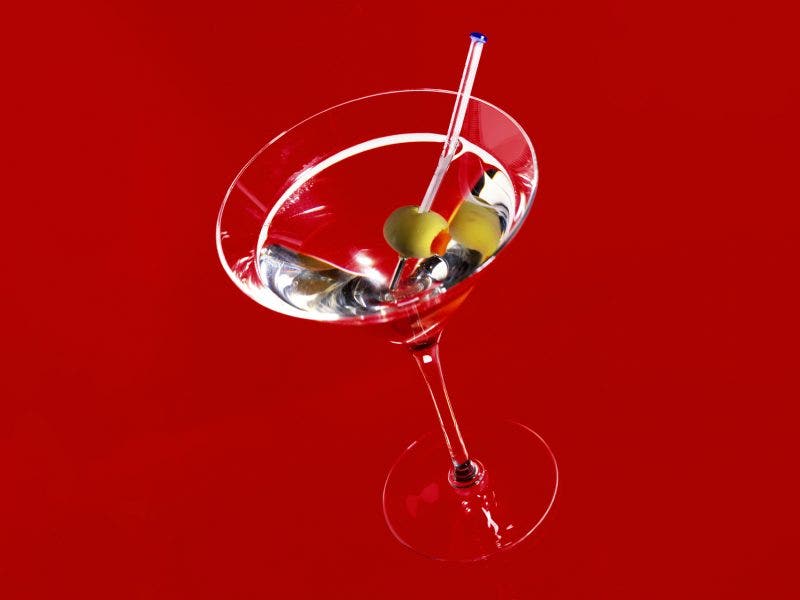All Hail the Classic Gin Martini

Do the words “Martini, shaken, not stirred,” ring a bell? Those immortal words, uttered by the fictional spy James Bond, are all the proof we need to declare the martini a classic cocktail of the highest order.
It’s a time-honored favorite for a few reasons: 1) its clean, refreshing flavor is unmistakable; 2) it inspired an iconic glass shape that’s stood the test of time; 3) its pristine, crystalline appearance just screams sophistication. But there’s more to a classic martini cocktail than meets the eye.
The History of the Martini
Like so many iconic drinks, the martini’s exact origin story is something of a mystery. One theory traces the martini to Gold Rush-era San Francisco, where legendary barman Jerry Thomas was slinging drinks at The Occidental Hotel on Montgomery Street.
“As the story goes, a traveler on his way to the town of Martinez, California, stepped into the bar, threw a gold nugget on the table, and asked Thomas to shake up something special,” shares writer Barnaby Conrad III in his book The Martini: An Illustrated History of an American Classic. “‘Very well, here is a new drink I have invented for your trip,’ said Thomas. ‘We’ll call it the Martinez.'”
In Thomas’s book How To Make Drinks or the Bon Vivant’s Companion, first published in 1887, he describes the Martinez as a concoction of bitters, maraschino liqueur, Old Tom gin, and vermouth. He serves it with a slice of lemon, unless “the guest prefers it very sweet,” in which case, he recommends adding two dashes of gum syrup.
Doesn’t sound quite like a classic martini, does it? That’s because—if you believe this version of the story—the Martinez continued to evolve, eventually transforming into what’s widely recognized today as the classic martini, which marries dry gin and vermouth.
However, another version of the martini origin story involves a famous brand name: Martini & Rossi. Created in the 1800s, this vermouth brand grew so popular that people allegedly began to ask simply for a “martini,” a truncated version of the brand name that became synonymous with a combo of vermouth, gin and bitters.
What’s the truth of the martini’s beginnings? We may never know. But there’s something about a mysterious origin story that makes a drink taste all the more delicious.
The Martini’s Modern Era
According to the Oxford Companion to Spirits and Cocktails, the 1950s saw martini innovations like the martini on the rocks. Although adding a glug of olive brine had been in practice since at least 1901, during this era the term “dirty martini” came to prominence. (The vodka martini emerged in the 1930s, but that’s another story for another time.)
By the 1960s and 70s, the gin martini was a holdout of the classic cocktail era, which had been largely supplanted by neon-hued, sweet beverages designed to mask the taste of alcohol. “The martini was deeply unfashionable, and those who drank it were lucky to get one at all,” the book reveals.
By the 1980s, however, it was back in style—paving the way for more modern takes like the espresso martini, the pumpkin spice espresso martini, the Fox Hunter martini, the dirty martini with a Paolo Bea Santa Chiara twist and more.
Directions
In a cocktail shaker filled with ice, combine gin and vermouth. *Stir well, about 20-30 seconds, then strain into a chilled martini glass. Garnish with olive or lemon twist.
*Classic martinis should be stirred, not shaken
FAQs
What Ingredients Are in a Classic Martini Recipe?
Rather boozy, a classic martini cocktail includes both gin and vermouth. It’s often garnished with a lemon peel or an olive. The vermouth used is normally dry, so that gin’s savory botanical flavors will come to the fore.
What Is a Dirty Martini?
A dirty martini is a classic martini splashed with olive juice. It packs a deep umami kick, which is deeply enjoyable to those who prefer savory drinks over sweet ones.
What Is a Dry Martini?
In martini parlance, “dry” means that it uses less vermouth. According to The Little Black Book of Martinis, a “four to one ratio became a medium dry martini; a six to one ratio, a dry martini; an eight to one ratio, a very dry martini; and an arid martini called for a ratio of twelve to one.”
What Is a Wet Martini?
A wet martini is the opposite of a dry martini. According to Gin: Distilled, in a wet martini, “gin is combined with a larger amount of dry vermouth, usually in a 3:1 ratio.”
What Does A Martini Taste Like?
That depends on the kind of martini you order. If you like a classic “dry” martini, it will taste like cold gin due to the increased amount of gin in the cocktail. If it’s “wet,” it’ll taste a bit sweeter because of the increased amount of vermouth. And if it’s “dirty,” it’ll taste more savory because of the olive juice.
How Do You Make a Vodka Martini?
A vodka martini is just that—a martini made with vodka in place of gin as the base spirit.
Are There Any Martini Variations?
They say that imitation is the sincerest form of flattery. And if that adage is right, the classic martini is, perhaps, the world’s most complimented cocktail.
There are many versions of the martini, including the vodka martini, dirty martini, lemon drop martini, Vesper martini, espresso Martini, and even a pumpkin spice espresso martini. All of these martini recipes take their cue from the first and O.G. one, the classic martini.